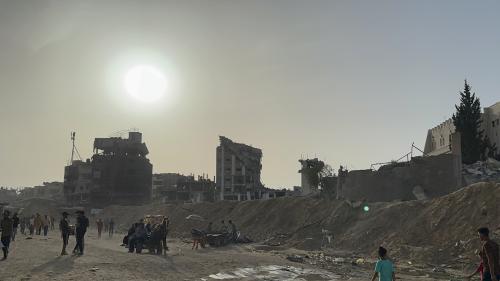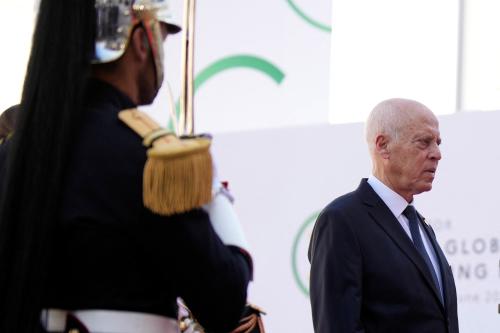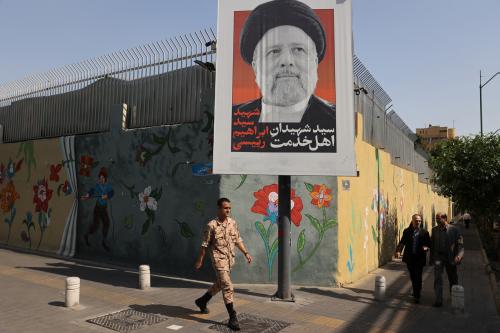Now that President Bush has issued a final ultimatum to Saddam and war seems inevitable, a key question is how hard Iraq’s soldiers will fight. Military estimates of the likely casualties from a war, its duration, and its impact on both Iraq’s civilian population and neighboring states are highly dependent on this variable. Indeed, U.S. military forces plan to make major efforts—both in terms of psychological warfare and actual military operations—to try to convince Iraq’s soldiers that Saddam Husayn’s doomed regime is not worth fighting and dying for.
The history of the Iraq-Iran War (1980-1988) and the Gulf War (1991) provide some indications of the likely willingness of Iraqi soldiers to fight and die in the event of a U.S. invasion. One lesson may be drawn at the outset: in the Iraq-Iran War the Iraqi army was fighting to defend Iraq’s territory, and this proved to be a critical motivating factor. Even though Iraq’s military professionalism was mediocre at best and Iraq’s fighting spirit (especially in the infantry units where some 80 percent of the soldiers were Shi’ah) was low, morale was still markedly higher than during the Gulf War. This suggests that, in 2003, even though most of Iraq’s soldiers are probably reluctant to risk their lives for Saddam, at least some of them will still be willing to fight harder than in 1991 because this time they will be defending Iraq, not Kuwait—which only few of them regarded as an integral part of Iraq.
THE REGULAR ARMY
Iraq’s regular Army probably will not offer much resistance to a U.S.-led invasion. Even Saddam seems to believe this, and has relegated them to the secondary mission of trying to slow and bloody U.S. forces as they first push into Iraq’s periphery. According to Western intelligence assessments, regular Army morale was very low throughout the mid- and late 1990s. As one symptom of this problem, desertion rates remained high, reaching 20-30 percent in Army field units. Baghdad’s military selection and promotion processes, based on ethnic and sectarian considerations, coupled with the regime’s frequent political purges and Stalinist control methods, have contributed to the low morale of officers and men alike.
The disdain with which the ruling party and Saddam Husayn in person have treated Iraq’s officer corps does not help. In the first place, people who were regarded by many officers as undeserving were promoted to the highest ranks. Some 20 percent of Iraq’s general officers hail from Tikrit, a town of 30,000-40,000. This “Tikritization” of top military ranks has aggravated the officers’ frustration. Most were deeply offended and frustrated to see politicians and mediocre colleagues overtake them so easily.
The Army has been a low priority for the regime. It has received little in the way of new hardware and spare parts and its training has largely been neglected since 1991. These patterns have been important elements in its low morale, especially when regular Army personnel compare their lot with that of the Republican Guard, which receives the best equipment, most of the available spare parts, and (relatively) lavish funds for training. In addition, over the years the regime has executed a number of senior Army officers who objected to carrying out attacks on the civilian populations of southern Iraq. Thus, it is not surprising that there have been numerous reports of coup attempts from the Army over the last 15 years.
As a consequence of these morale problems and the resentment harbored by many officers toward the regime, many Army units may be expected to disintegrate early on. This is particularly the case with the Army’s 11 infantry divisions. At the same time, however, its three armored and three mechanized divisions may be expected to put up more serious opposition. During the Gulf War, several of Iraq’s regular Army heavy divisions fought hard, albeit not as hard as the Republican Guard. They too might break and run once they face superior American air and ground forces, and if Iraq’s command and control are seriously disrupted. However, they may not run home as quickly as they did in 1991 because this time they will be defending Iraqi territory.
THE REPUBLICAN GUARD
The Republican Guard remains the most potent conventional military force in Iraq, although it too has eroded since the Gulf War. In August-September 1996 it easily defeated Jalal Talabani’s Kurdish forces and conquered the northern city of Irbil. Almost all of Iraq’s top-of-the-line T-72 main battle tanks, some 600-700 of them, are allocated to the Guard. Since about 1986, the Guard has been Iraq’s elite, essentially built by the General Staff to improve Iraq’s overall military performance. The Guard eventually became the regime’s solution to two problems presented by the failings of the regular Army against Iran. One problem was the Army’s paltry capabilities and fighting spirit, and the other was its increasingly doubtful support for the regime as a result of its humiliation by the civilian party leadership.
Initially, the Guard was expanded in 1986-88 from six brigades to 28 by plucking all of the best personnel and officers from the regular Army and reassigning them to the Guard. However, because the Guard always retained an internal security role as well, the political loyalty of Guard officers eventually came to equal military professionalism as a prerequisite for promotion. Many officers in the Guard hail from Saddam Husayn’s home town of Tikrit, from his Albu Nasir tribe, and from other friendly tribes, mostly Sunni Arab (from al-Anbar, Diyala, Nineveh-Mosul), but also from the Shi’ite tribal areas. Still, in a number of cases Republican Guard officers were involved in coup attempts against the regime throughout the 1990s—which suggests that the U.S. might be able to appeal to Guard commanders to turn on Saddam once his fate is clear.
Nevertheless, the Guard has generally remained loyal to Saddam and whenever it has been involved in combat, it has fought harder and better than any regular Army units. Moreover, Guard units have never surrendered or fled from the battlefield in the face of a superior enemy.
The Guard units who fought against the U.S. VII Corps during the Gulf War are a good example. They were generally well deployed and dug in, but were badly outmatched. Not only were they outnumbered, their equipment could not compete with that of their American opponents: while American M-1 tanks could penetrate the Iraqi T-72s from over 4,000 meters away, the T-72s could penetrate the frontal armor of the M-1 only at a very close range. All the same, the Guard fought back with great tenacity, and there was no evidence that any of its units withdrew without authorization. This was in contrast to the behavior of the regular Army units, in which many crews simply deserted their tanks.
Even if the Guard fights as hard as it did during the Gulf War, it simply lacks the numbers, the equipment, or the skills to actually defeat a U.S. invasion. However, Saddam’s one hope is that the threat of a vicious fight for the city of Baghdad itself will deter an American assault, and in this case, the Guard is all important, because it is the Guard he is counting on to remain loyal and fight in defense of Baghdad. Some armored units of the Guard will start the main defensive battle a few scores of miles from Baghdad, defending essential choke points and slowing down the American forces. Other Guard units will be deployed on the outer edge of the capital city. The more loyal units will eventually be ordered to withdraw into the city and fight while hiding behind the civilian population. Saddam is hoping that the Guard will remain committed and cohesive and the U.S. won’t have the stomach to take it on in urban combat in the capital.
THE SPECIAL REPUBLICAN GUARD
The Special Republican Guard (SRG) was established in 1981 as the Quwwat al-Tawari’ (The Emergency Forces). In 1985-86, it was expanded and renamed the SRG. It is almost exclusively an internal security force and has little training for conventional combat. Its main task is to maintain order in the capital city and put down any revolt or coup attempt. It also has security duties in four presidential palaces outside of Baghdad. Its forces are spread mostly inside Baghdad at strategic intersections. In the event that the Shi’ah of Saddam City rise in revolt, the SRG will move to seal the quarter off and start shelling it indiscriminately. The SRG command falls under the Office of the SRG Affairs of the SSO, and thus is under the direct command of Saddam’s most trusted son, Qusayy Saddam.
Most officers and soldiers in the SRG hail from Saddam’s tribe and from his hometown of Tikrit, as well as some friendly tribes and neighboring towns, like Dur and Bayji. They are brought to the capital city when they are between the ages of 15 and 19 and are educated, trained, and indoctrinated into Saddam’s cult of personality to ensure their loyalty to him alone. They enjoy extensive privileges, and for poor village boys with limited education, becoming the security “masters” of Iraq’s haughty capital city is like an incredible dream. As a result, the SRG’s loyalty to Saddam is considered extremely high, if not absolute.
In the case of war, even if American forces are widely seen as having overwhelming advantages, the SRG will certainly fight. Saddam has concentrated most of its 25,000 troops in Baghdad itself. Their task will be to inflict such losses on U.S. forces that Washington will call off the operation. In addition, the SRG will almost certainly use Iraqi civilians as live shields, leaving American commanders to choose between risking the lives of American soldiers or those of thousands of Iraqi civilians. Saddam will no doubt bank on international pressure to rein in the U.S. leadership. While there is some chance that Republican Guard units might turn on Saddam, there is little reason to expect that SRG units would do so. However, with a determined psychological warfare campaign, the U.S. might persuade many of them to give themselves up once they realize that all is lost.
JIHAZ AL-AMN AL-KHASS (SPECIAL SECURITY ORGANIZATION, SSO)
The SSO was created by Saddam’s cousin and son-in-law, Husayn Kamil, in the late 1980s as a small inner security force consisting mostly of officers. Their main task is coordinating Saddam’s protection. They were picked out from Army units and the Guard (although most of them were from Tikrit or Saddam’s tribe), and given authority over all other intelligence and domestic security bodies whenever the security of the president and his family was involved. Soon after it was established, the SSO also was placed in charge of the non-conventional warheads of the Iraqi missile force because of their great loyalty to Saddam. After the Gulf War, because Husayn Kamil headed both the SSO and the Military Industrialization Organization (MIO), the SSO also began to play a role in the procurement and protection of Iraq’s clandestine WMD programs.
At that time, the SSO was also considerably enlarged and today it boasts as many as 5,000 men, still with a high percentage of officers. The SSO is the most feared of all the Iraqi security services and its authority supersedes every other military or security force. It is under the direct command of Qusayy Saddam Husayn and General ‘Abd Hamid Hamud, the president’s personal secretary. The SSO is very effective in its internal security mission and very loyal, but as a fighting force it does not count for much. They are interrogators and executioners, not warriors. Still, they might play a disproportionate role in the campaign: SSO officers are assigned to every major military command and their job is to ensure that the commanders execute Saddam’s orders on pain of death—including orders to employ WMD.
HIMAYAT AL-RA’IS (THE PRESIDENTIAL GUARD)
The Presidential Guard consists of several thousand young men from Saddam’s tribe and village who are responsible for protecting the president, his family, and his closest associates, including the party’s luminaries. For the most part, the Himaya protects the various palaces and other houses where the president spends his days and nights and secures those compounds in Baghdad where the regime’s top officials live. There has never been a report of any disloyalty among the Himaya. Its men are well trained, they are loyal, they are young, they admire Saddam and fear him, and they are not very well educated—which means they do not have much hope to succeed anywhere else. They are all grateful to Saddam for what he has done for them. Finally, some of them have performed crimes in his service and so have enemies waiting to avenge the blood of relatives. As long as their command system is more or less intact, they should be expected to fight hard. However, once this system disintegrates they will probably lose heart. If they believe that Saddam has fallen, and if promised fair treatment or amnesty, they may be tempted to surrender. Still, it has to be emphasized that the Himaya—like the SRG and SSO—is likely to put up strong resistance.
JAYSH AL-QUDS (THE JERUSALEM ARMY)
After the outbreak of the al-Aqsa Intifadah in the Palestinian territories, Baghdad created the “Jerusalem Army” with, it claimed, seven million people to liberate “Palestine from the [Mediterranean] Sea to the [Jordan] River.” It is highly unlikely that the Jerusalem Army has anywhere near this number of personnel: Iraq’s total population is around 24 million, and amounts to only 19.5 million without the Kurds of northern Iraq. Thus, more than one out of every three Iraqis—including women, children, and the elderly—would have to have volunteered. The Jerusalem Army is under the political supervision of Qusayy Saddam Husayn, who also controls the Republican Guard and Special Republican Guard. At least eight retired generals, led by a former commander of the Guard, Lt. General Iyad Khalifa al-Rawi, were reportedly called back to service to build the force. There is evidence that men and even women are forced to join this new army: if they refuse, they and their families are punished. Those who do join, willingly or unwillingly, are not paid any salary and their training lasts only a few months. Consequently, it seems highly unlikely that this “army” will fight. Indeed, it seems that the Jerusalem Army is actually intended to serve a different set of goals. First, it allows Baghdad to keep many men, almost all of them Shi’ah, under supervision during the war. Second, it might be used to bog down the advancing American forces with tens of thousands of prisoners of war.
THE SADDAM FIDAYYIN
This force of 20,000-40,000 men was established in 1995 by Saddam’s elder son Udayy. It is another of the multitude of internal security organs in Saddam’s police state, and contributes to his reign of terror by arresting and executing Iraqis suspected of opposition to the regime. According to some reports, its men engage in such official duties as cutting out the tongues of people overheard criticizing Saddam and decapitating young women they have accused of prostitution. At least once, in 1995, they participated in the suppression of a local revolt in Ramadi, west of Baghdad. They are cruel and primitive, many of them country boys whom Udayy offers social and economic favors. Although they are feared inside Iraq, they are not a fighting force to be reckoned with: they are lightly armed and badly trained. However, because they have been implicated in so many crimes, they might fight for their lives if they believe they have no other choice.
CONCLUSION
If and when US ground forces advance on Baghdad, whether they come from the south or north, they will first face regular Army units and the Jerusalem Army, which probably will not prove to be significant obstacles. Some of the regular Army heavy divisions may offer some resistance, but the infantry divisions and the Jerusalem Army will be easily dispersed. Some Iraqi formations may succeed in slowing the U.S. advance simply by surrendering en masse. Small pockets of resistance notwithstanding, U.S. forces probably will not encounter too many difficulties on the road to Baghdad. Their greatest problems are likely to be logistical: Saddam’s troops may make every effort to blow up bridges and to open the gates of barrages and dams. Baghdad might flood parts of the southern marshes that were drained in the early 1990s to drive out army deserters and guerillas. In addition, U.S. soldiers may have to deal with civilian casualties from Iraqi WMD attacks.
U.S. forces will face their greatest challenge as they close in on Baghdad, where they will confront the four Republican Guard heavy divisions—and possibly its two infantry divisions as well. In addition, Saddam will have both Republican Guard Special Forces brigades and the SRG in Baghdad. All of these units can be expected to put up a brave fight. Moreover, it is doubtful that a sophisticated psychological warfare campaign could induce units of the Republican Guard or SRG to actually topple Saddam and save the U.S. the need to conquer Baghdad. Saddam’s whereabouts are known only to a very few, and the organization and coordination needed for a coup will be difficult to cobble together in the confusion following a U.S. attack. Unless the U.S. has already established contacts with the commanders of a unit, a coup d’état is highly unlikely. Still, if approached properly, many Guard commanders may decide to surrender once they conclude that continued opposition can only lead to their demise and that they will be pardoned if they surrender—and possibly even allowed to reintegrate into a reformed Iraqi army.


